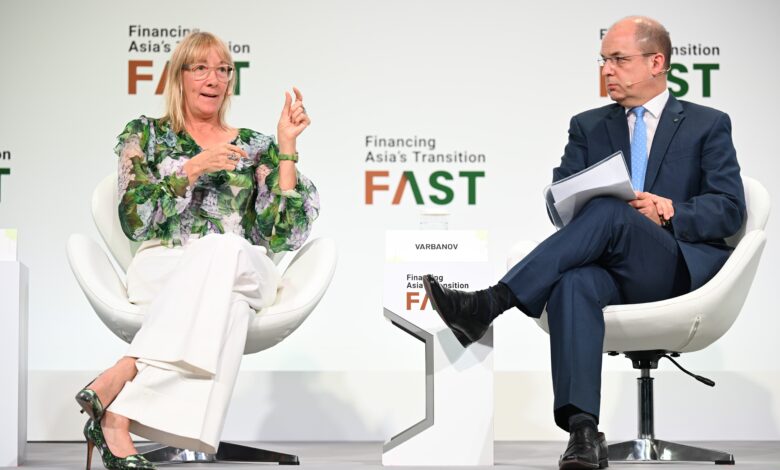Expect up to 12x returns for every dollar spent on climate adaptation: StanChart

EVERY dollar that’s invested into climate adaptation and resilience could generate economic benefits worth 12 times as much, said Marissa Drew, the chief sustainability officer of Standard Chartered.
And that does not include the co-benefits that could come from the multiplier effect of investing, said Drew, who was speaking at the recent Ecosperity sustainability conference held in Singapore.
The figure was derived from a guide – developed by the bank, KPMG and the United Nations – on how capital can be mobilised towards climate adaptation and resilience.
Climate adaptation is one of the two main pillars of climate action; the other being mitigation.
Adaptation has historically been underfunded and receives much less financing from the private sector, which has generally channeled capital towards mitigation projects as these tend to be productive assets that can generate an income, such as a solar power plant.
Besides the fact that the focus has been on reducing greenhouse gas emissions instead of adjusting to increasing risks of climate change impacts, climate adaptation tends to mean public infrastructure projects, such as coastal defences or drainage systems, which do not lend themselves to commercial financing models.
A NEWSLETTER FOR YOU

ESG Insights
An exclusive weekly report on the latest environmental, social and governance issues.
However, Drew noted during a panel discussion that the investment case for climate adaptation projects comes from the increasing necessity of such goods and services – with all metrics indicating that the world is not on track to limit global warming to 1.5 degrees Celsius – and therefore demand for them.
Echoing similar sentiments, Jay Koh, the co-founder and managing director of The Lightsmith Group, said the challenges brought about by climate change present “unavoidable opportunities”.
Citing the sixth assessment report by the Intergovernmental Panel on Climate Change, Koh, who runs a private equity firm that focuses on climate resilience solutions, said that the trajectory of climate change between the present day and 2030 is almost entirely baked in by greenhouse gas emissions that have already accumulated.
“So there is a great growth investment opportunity – that is intertwined with the decarbonisation investment strategies that people are pursuing in the market – for climate resilience and adaptation solutions,” said Koh, who was speaking at the same panel.
One example is an artificial intelligence company that analyses vegetation management for utility companies. Given that many major wildfires in the United States and Australia are sparked by vegetation encroaching onto power lines, most utility companies are managing this problem by having workers manually cut down trees getting too close to the power lines.
With satellite drone imagery, utility companies are able to manage such risks in a much more efficient way.
Yet, Drew pointed out that there is still currently a low level of awareness and understanding among financial institutions on what constitutes adaptation finance.
In the midst of developing the guide, she was often asked by banks and asset managers: “What do you mean by (adaptation finance)? Do you mean “loss and damage”? Isn’t that the job of the government?”
“Loss and damage” refers to a fund, established by countries at the United Nations climate change conference, that will be financed by developed countries to compensate developing countries experiencing the worst impacts of climate change.
There is therefore a need for the industry to have a common definition of adaptation finance and the commercial opportunities arising from it, as well as an understanding of the financing mechanisms and the type of projects available, said Drew.
“Inaction is not a world that you can conceive. It’s loss of economic prosperity, it’s loss of livelihoods, it’s people’s health, it’s life, et cetera… We can either invest in it now and do it in a nice, orderly way. Or we can wait till it’s disaster, and then it’s chaos,” she added.
The importance of taking adaptation and resiliency actions early is also highlighted by Lubomir Varbanov, Swiss Re’s managing director and head of public sector solutions for Asia-Pacific.
Physical impacts from a climate event can be mitigated if climate resiliency is built into urban planning sufficiently early, he said at the same panel.
It is a misconception that disaster risk insurance only has a role to play in the aftermath of a climate disaster as a shock absorber, Varbanov noted.
He cited an example of Swiss Re partnering with local governments in Australia to financially quantify their natural hazard risks. This allows them to pre-emptively identify their highest risk assets across all types of natural disasters and their locations, so as to factor this information into their planning processes.
If more action to increase climate resiliency is not taken, the rising costs of insurance will lead to affordability issues, especially for vulnerable communities.
Varbanov noted that four of the last five years have seen over US$100 billion of insured losses from natural disasters.
He said that there needs to be more public and private partnerships, where data is shared and common objectives are set.
An enabling environment, with regulations that promote an open market and optimal price setting that does not make the insurance industry more expensive, are also important.
On the issue of policy reforms, Drew noted that local governments often cite how policy suggestions, such as the redirection of subsidies, are politically challenging to implement.
However, she added that it is important for the private sector and development finance institutions to highlight to policymakers how these policy reforms “are going to actually create an enormous amount of opportunity for the livelihoods of (their) people”.
“So politically, (they’re) helping (their) people. (They’re) creating that longevity and that resiliency and that endurance.” said Drew, referring to governments.

